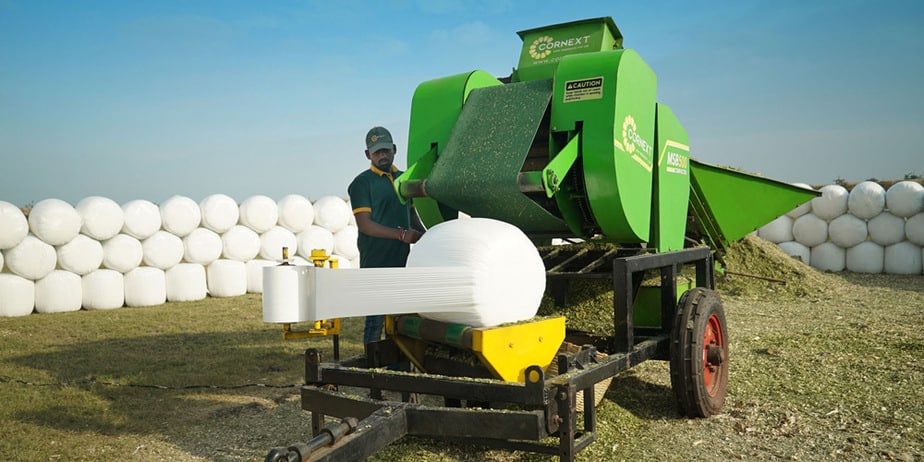According to a report by The Wire, only 4% of India’s land area for crops is dedicated to fodder cultivation for animal feed. Another study forecasts India is expected to experience a shortfall in green animal fodder of 65%by 2025. This is a grim scenario for a country of 1.3 billion people depending on livestock for healthy food requirements like milk. Thankfully, technology today has created techniques like silage making to cultivate quality crops and ensure high-quality forage that provides adequate nutrients to the livestock and is also easily digestible by them.
Baled silage is conditioned or curated fodder stored for consumption by livestock during dry or non-harvest seasons. It is prepared through a technological and sophisticated process of wilting and fermenting high-nutrient crops followed by storing them in bundles or silage bags.
For a cost-conscious farmer base in India, the process could prove to be a significant investment, that’s where Cornext comes into play as one of the best silage manufacturers in India. Cornext ties up with the farmers and processes their corn crops and converts them into silage bales and pays the money what they deserve. Let’s review the key steps essential to create high-quality baled silage to improve quality livestock yield.
1. Developing Quality Yield with High Digestibility
Silage making requires significant capital investment at the beginning, therefore the farmer or landowner must get all the elements right. It also means getting the basics right. The silage which is the end product going into the package created by silage making machines must be a quality crop of very high feed value (approximately 75+ DMD). Cutting crops when they have the highest nutritional value results in animals delivering high-yield products, be it milk.
Moreover, the grass crops must be harvested when seed-heads begin to arise for easy digestibility by the animals. For preserved grass like hay, they must be cut before full maturity stage for digestibility and for the nutrients to stay for the shelf life till the time of use. Yield and digestibility play a huge role in providing adequate nutrition for the cows to deliver high-quality milk, or for livestock ( goats, sheep, etc..) to have better sale prospects in the market.
2. Getting the Baling Process Right
Once the silage is ready after processing and curing, packaging becomes critical, especially for consumption a few months after harvest. Usually, they are consumed during the winter or dry season. Baling is the key step as part of making the fodder ready for storage. Silage packing can be manual but silage making machines deliver the best results with quality, precision, and cost-effectiveness. Having well-shaped swathe that matches the pick-up for the baler and modifying settings to create the best baler density expected are key steps to note. Few techniques during silage making that sound insignificant like tractor-driving techniques to generate balanced grass flow, are important to create quality output. Today’s technology allows up to 550+ kgs of silage to be stored in a single silage bag, showing the compact nature of the product.
3. Mastering Wrapping Techniques
Wrapping takes additional precautions to ‘secure the package’ against unwanted elements like rodents or inclement weather like rain or gusty winds. However, its primary objective is to eliminate any oxygen seeping in from outside, and the content needs to be “airtight” until it is opened for livestock consumption. The plastic of the silage bags needs to be of high quality. The silage wrapping technique is typically done by a separate wrapper machine or the default silage making machine having a wrapping mechanism. A film of adhesive insulates the content and protects even against unintended handling scenarios during transportation. It is wise to choose the right mechanism of wrapping to prevent future silage loss.
4. Storage & Preservation Tips
One cannot emphasize the importance of storing the bales in an optimum environment to ensure the silage is as good as it was promised to be for the livestock. A couple of ways to begin this for the silage-making machine is to compress the grass as much as possible and store in bales to ensure the output is fresh, even after many months.
Select an open warehouse that is relatively closed at all sides. Unwilted bales that is not dried well should be stored on the ground on the curved side compared to wilted bales that can be stacked on one another, on the curved side itself. Store Silage bales on hard and smooth surfaces so multiple units can be stacked on one another, and retrieved easily. It is also recommended that a mesh netting covers the outer portions of the bales, to prevent any damage from pests or birds.
5. Handling & Transporting with Care
It is recommended to transport silage bales to a storage area within a day of wrapping, and here is where caution must be exercised. Given the fresh feed that has gone into the silage bags, delaying the shift to the store area might make it difficult to lift, apart from threats like birds rupturing them. After the silage making process, the bundles must be carefully lifted from the silage making machine, placed on the vehicle and driven slowly to the desired location. Transport vehicles or lifting equipment must be regularly checked to ensure mechanical failures do not affect the integrity of the silage bales. It is ideally recommended to wrap the bale at the storage area itself, to reduce any unwanted issues during transportation.
With today’s fluctuating market conditions, changing weather patterns and the rising demand to allocate land for fodder cultivation, silage making has become a prominent activity to address the fodder requirements for livestock . Our silage making machines and Cornext Baled silage are being widely used in farms across the country. Drop us a line on email or Whatsapp, and we will connect to understand your requirements.


